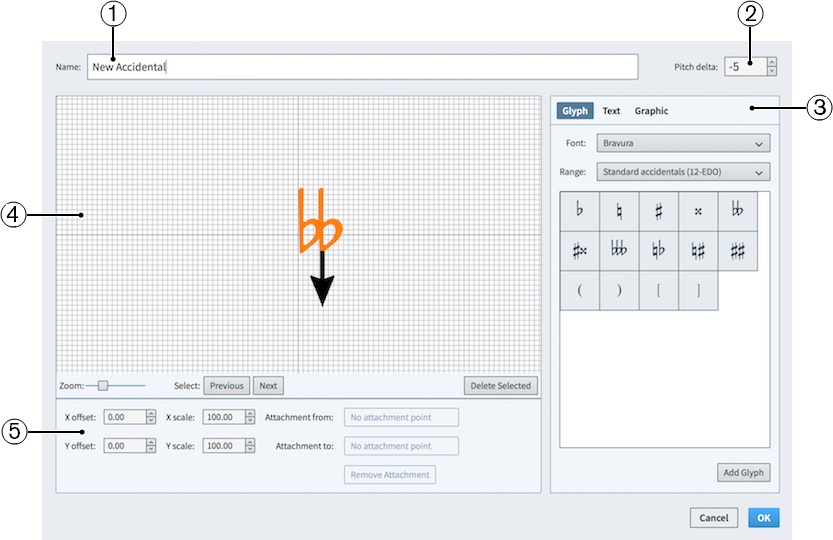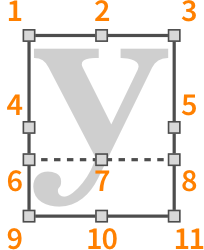Edit Accidental dialog
You can create new and edit existing custom accidentals in the Edit Accidental dialog.
-
You can open the Edit Accidental dialog by clicking either New Accidental or Edit Accidental in the action bar at the bottom of the Accidentals section of the Edit Tonality System dialog.

The Edit Accidental dialog contains the following sections:
-
Name
Allows you to enter a name for your accidental.
-
Pitch delta
Allows you to set a value for what effect this accidental has on notes to which it is added. For example, a pitch delta of 2 raises notes by two equal divisions of the octave.
-
Accidental component selector
Allows you to choose components to add to your accidental. You can add different types of components by clicking the respective tab titles.
-
Glyph includes symbols such as ♮ and ♯. You can use different styles of glyphs by selecting different fonts and different ranges from the menus. Click Add Glyph to add the selected glyph to the accidental.
NoteA full list of the different ranges of glyphs is available on the SMuFL website.
-
Text includes numbers and other text. You can use numbers and text from the available Preset text list, or select any font available from the menu and enter your preferred text into the text box at the bottom. Click Add Text to add the selected text, or input text, to the accidental.
-
Graphic: Load a new graphic file, or select an existing graphic from the Select existing list. You can see a preview of the graphic in the Preview box. Click Add Graphic to add the selected graphic to the accidental.
-
-
Editor
Allows you to arrange and edit the components that make up your accidental. You can use the controls at the bottom of the dialog to edit and arrange accidental components.
-
Controls
-
X offset moves components horizontally. Increasing the value moves components to the right, decreasing the value moves components to the left.
-
Y offset moves components vertically. Increasing the value moves components upwards, decreasing the value moves components downwards.
-
X scale changes the width of graphics only. Increasing the value makes graphics wider, decreasing the value makes graphics narrower.
-
Y scale changes the size of components and the height of graphics. Increasing the value makes components larger, decreasing the value makes components smaller. For graphics only, increasing the value makes graphics taller, decreasing the value makes graphics shorter.
-
Attachment from: Select the attachment point on the component to the left of the selected component to which the selected component attaches. We recommend that you select a right edge attachment point for Attachment from.
-
Attachment to: Select the attachment point on the selected component which attaches to the component to its left. We recommend that you select a left edge attachment point for Attachment to.
-
There are eight attachment points for glyphs and graphics, and eleven for text, due to the extra space required for letters that go below the baseline. The example diagram helps you visualize how these points relate to accidental components.

The attachment points have the following names in the Edit Accidental dialog:
-
Top Left
-
Top Middle
-
Top Right
-
Left Middle
-
Right Middle
-
Baseline Left (text only)
-
Baseline Middle (text only)
-
Baseline Right (text only)
-
Bottom Left
-
Bottom Middle
-
Bottom Right